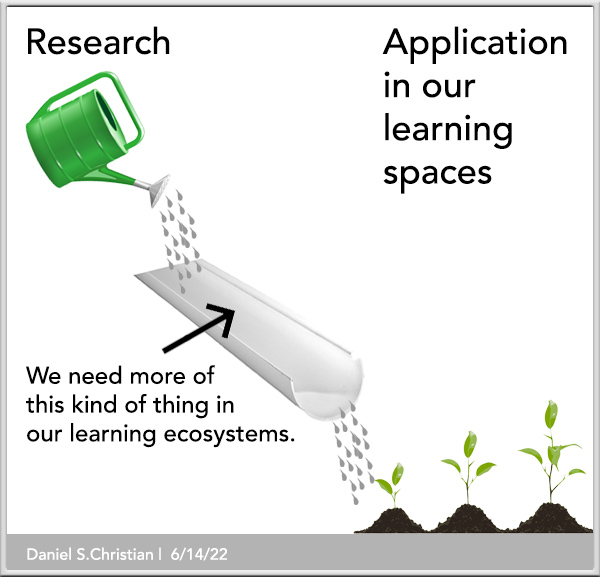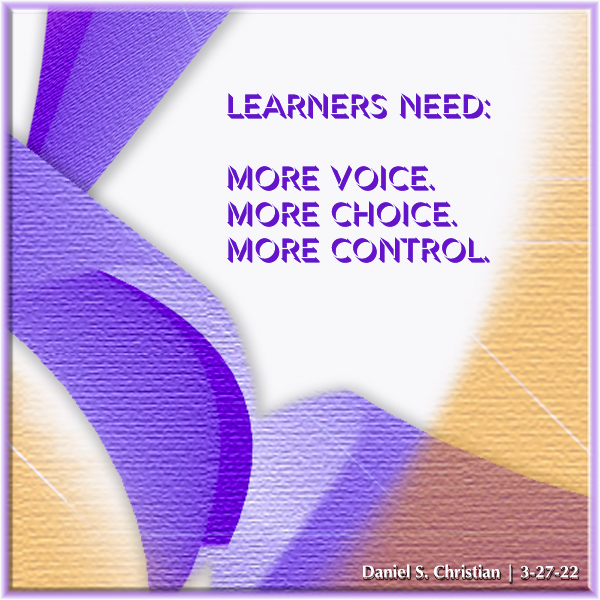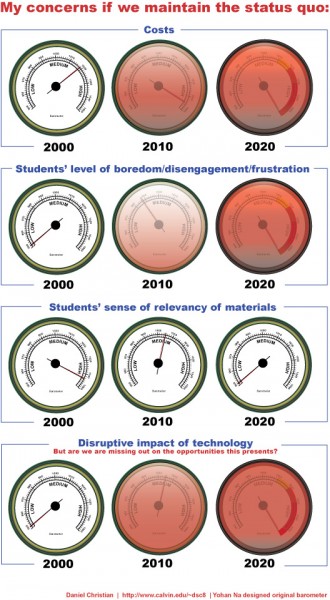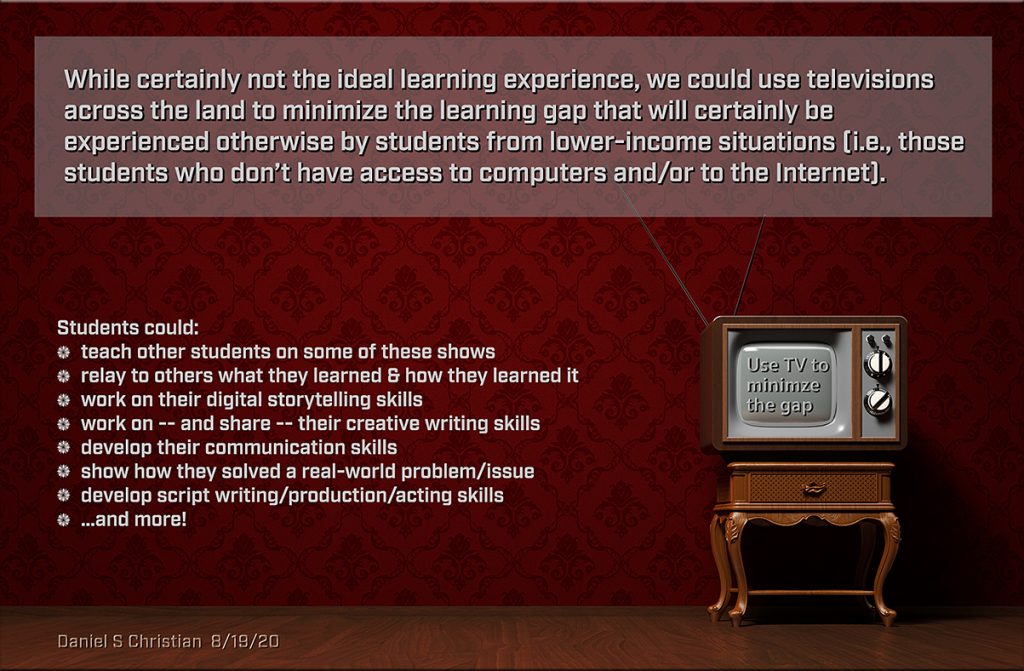20 Ideas You're Using Video Meetings With Students —Infographic
? https://t.co/jQBkibc1Qq#videomeeting #studentengagement pic.twitter.com/U7wNrnUpj0
— eLearning Industry (@elearnindustry) July 13, 2022




20 Ideas You're Using Video Meetings With Students —Infographic
? https://t.co/jQBkibc1Qq#videomeeting #studentengagement pic.twitter.com/U7wNrnUpj0
— eLearning Industry (@elearnindustry) July 13, 2022
Encourage Learning Over the Summer with Buncee & PebbleGo Create — from rdene915.com by Rachelle Dene Poth
Excerpts:

In each of these, there are opportunities for students to take a close look at the world around them and become curious about learning. Students can connect with things that are happening in the real world.
Another item from Rachelle:
From DSC:
In my last position, we used IPEVO devices as well. I purchased one for my sister last year as well. They do the job quite well — at a very decent price.
7 Surprising Ways ADHD Shows Up in the Classroom — from additudemag.com by Mark Bertin, M.D., Beverley Holden Johns, Kathy Kuhl
ADHD in the classroom is easy to mistake for carelessness, defiance, laziness, or a learning difference. Here are the 7 ADD symptoms that educators seldom recognize at school — and solutions for each.
Excerpt:
ADHD sometimes manifests in obvious ways — like when a second grader blurts out an answer (again) or when a high school student forgets her completed assignment at home (again). Just as often, though, signs of ADHD in the classroom are more subtle and easily overlooked because they don’t align with stereotypes. Here are seven less-recognized ways ADHD symptoms show up at school, and productive ways to address each one.
Also relevant/see:
From DSC:
Below are several observations re: our learning ecosystems — and some ideas on how we can continue to improve them.
It takes years to build up the knowledge and skills in order to be a solid teacher, faculty member, instructional designer, and/or trainer. It takes a lot of studying to effectively research how the brain works and how we learn. Then we retire…and the knowledge is often lost or not passed along. And the wheel gets reinvented all over again. And again. And again.
Along these lines — and though we’re making progress in this area — too often we separate the research from the practical application of that research. So we have folks working primarily in learning science, neuroscience, cognitive psychology, and related fields. But their research doesn’t always get practically applied within our learning spaces. We have researchers…and then we have practitioners. So I greatly appreciate the likes of Pooja Agarwal and Patrice Bain out at RetrievalPractice.org, Daniel Willingham, Eva Keiffenheim, The Learning Scientists, James Lang, and several others who bridge this gap.

Perhaps more researchers, faculty members, teachers, trainers, instructional designers, principals, provosts, etc. could blog or be active out on social media.
***
Along these lines, we need to spend more time helping people know how best to study and to learn.
If that type of thing is ever to be learned, it seems like it’s often learned or discussed in the mid- to later years of one’s life…often after one’s primary and secondary days are long gone.
Instead, we should consider putting these easy-to-understand posters from the Learning Scientists in every K-12 school, college, and university in the nation — or something like them.
***
To provide the most effective engaging learning experiences, we should consider using more team-based approaches. As appropriate, that could include the students themselves.
***
We put way too much emphasis on grades — which produces gameplayers who seek only to do the minimum amount of work necessary to get the A’s. Doing so creates systems whereby learning is not the goal — getting a 4.0+ is.
***
As we are now required to be lifelong learners, our quality of life as a whole goes waaaay up if we actually enjoy learning. Many people discover later in life that they like to learn…they just didn’t like school. Perhaps we could place greater emphasis within K-16 on whether students enjoyed their learning experiences or not. And if not, what might have made that topic more enjoyable to them? Or what other topics would they like to dive into (that weren’t’ on the original learning menu)?
This could also apply in the corporate training/L&D space as well. Such efforts could go a long way in helping establish stronger learning cultures.
***
We don’t provide enough choice to our students. We need to do a better job of turning over more control to them in their learning journey. We turn students off to learning because we try to cram information that they don’t care about down their throats. So then we have to use the currency of grades to force them into doing the work that they could care less about doing. Their experience with learning/school can easily get soured.

We need to be more responsive with our curricula. And we need to explain how the information we’re trying to relay is relevant in the real world and will be relevant in their futures.
***
So those are some ideas that I wanted to relay. Thanks for your time and for your shared interests here!
‘Accessibility is a journey’: A DEI expert on disability rights — from hrdive.com by Caroline Colvin
Employers can wait for a worker to request reasonable accommodation under the ADA, but Kelly Hermann asks: Why not be accommodating from the start?
Excerpt:
Often, employers jump to the obstacles that exist in physical spaces: nonexistent ramps for wheelchairs, manual doors that lack motion sensors, and the like. But the digital world presents challenges as well. Hermann and the U Phoenix accessibility team likes to “demystify” disability for campus members seeking their counsel, she said.
“Are you making those links descriptive and are you using keywords? Or are you just saying ‘click here’ and that’s your link?” Hermann asked. Like a sighted person, an individual with a disability can also scan a webpage for links with assistive technology, but this happens audibly, Hermann said, “They tell that tool to skip by link and this is what they hear: ‘Click here.’ ‘Click here.’ ‘Click here.’ ‘Click here.’ With four links on the page all hyperlinked with ‘click here,’ [they] don’t know where [they’re] going.”
New Pathways: Experiencing Success In What’s Next — from Getting Smart
Excerpt:
Some of you were able to attend our official kick-off event yesterday (on 6/21/22), but for those who weren’t able to make it we wanted to let you know that our new campaign, New Pathways, has officially begun!. Over the next few years, and in partnership with ASA, the Bill & Melinda Gates Foundation, Stand Together and the Walton Foundation, we will be dedicated to tracking innovations in the following six pillars:
How parents can set up a productive home learning space for students — from blog.neolms.com by Charlie Fletcher
Excerpt:
Most schools have now reopened, and students across the nation and the world are back to learning in person. But, that doesn’t mean that remote learning is over. Plenty of schools still follow a hybrid model, and some students who fared better in remote learning conditions have stuck with virtual classrooms. This means that parents must know how to set up a productive learning space, both for remote learning and as a great study area.
Fortunately, there are plenty of resources to help parents and guardians who want to create a home learning space. This means that whatever your budget, every student can have their own space to study for exams and complete homework.
From DSC:
One of our daughters — the one who is going to be teaching third graders next year — said that the above siteand resources reminded her of Teachers Pay Teachers. So I thought I’d include that here as well.
From DSC:
The following items made me reflect upon the place of COVID-19 in causing the current ills within higher education — but also thinking about the ills that were present long before Covid hit us.
Key point:
We should be careful not to conveniently use COVID-19 as the scapegoat for all that’s wrong within higher education.
The Season of Our Professorial Discontent — from chronicle.com by Paul Musgrave
The pandemic irrevocably changed the student-teacher relationship — and not for the better.
Excerpts:
As pandemic slides into endemic, it’s worth asking: Did the pandemic break something fundamental about academe? Was the spring of 2022 the end of pandemic disruptions, or the start of a new normal?
…
This time, as I delivered the lines to an audience of 30 in a course with 200 students enrolled, I was wondering whether I wanted to give a lecture ever again.
From DSC:
Regarding the first quote…several things were broken within academe long before COID-19. Re: the second quote, what should that tell us if only 30 students showed up in a class with 200 students in it?
Faculty autonomy and faculty satisfaction are being whittled away.
From DSC:
From what I can tell, that’s been happening for years within the K-12 learning ecosystem. It seems like this trend is now occurring within the higher ed learning ecosystem. (I could go off on a tangent about why we didn’t help our fellow educators within K-12 — whose “product” directly impacts those working within higher ed — but I better not. This posting is already packed with reflections.)
Below are some relevant quotes from Kevin McClure’s 5/27/22 article out at The Chronicle of Higher Education (emphasis DSC). I agree with much of what Kevin is saying here.
Don’t Blame the Pandemic for Worker Discontent
It hasn’t just been a tough two years. It’s been a tough two decades.
Excerpt:
The pandemic alone didn’t cause the low morale and turnover you might be seeing among your faculty and staff members just as the lack of personal protective equipment didn’t solely give rise to the Amazon Labor Union. Yes, today’s workers are re-evaluating their workplaces, seeking reassignment within their institutions, and in some cases resigning from jobs altogether. But they are doing so for many of the same reasons they did 20 years ago — poor working conditions.
…
So burnout isn’t just about people struggling to cope with stress; it’s about people struggling in workplaces where stress never subsides.
…
In my own interviews on morale, higher-education workers have talked about leaders who aren’t listening, low compensation, and understaffing.
…
We see our workplaces differently, and our tolerance of poor working conditions has evaporated.
“It hasn’t just been a tough two years. It’s been a tough two decades.” The same — and likely more — could be said for the student side of the house, especially in regards to the price of education and how relevant/up-to-date the content has been. As the prices of obtaining a degree have skyrocketed over the last several decades, students and parents now HAVE to ask, “What’s the Return On Investment (ROI) here? Am I gaining the skills in college that will get me hired after college?”
Again, the point I’m trying to make here is that we should be careful not to conveniently use COVID-19 as the scapegoat for all that’s wrong within higher education.
Along these lines, the following two quotes seem relevant to me from Beth McMurtrie’s (6/2/22) Teaching e-newsletter (also from The Chronicle):
I asked Walton to tell me more about the setup at his university. He said classes were fully in person but instructors were encouraged to record lectures and be highly flexible with due dates. The result: Most days he had less than 50-percent attendance, and he received a lot of last-minute emails from students who said they woke up that morning with a headache or otherwise not feeling well. A few filed documented absence requests, but not many, suggesting that these were not serious illnesses, like Covid.
…
I’ve never had more incompletes for courses than in the last two years, so signaling to students that their distribution courses are flexible and accommodating has only let them de-emphasize them even more.
There’s likely a variety of causes/possibilities here — and I’m sure that Covid-related reasons are among them. But it makes me really wonder if students don’t think that the content is all that valuable or relevant to begin with these days. Is college even worth it anymore? Why am I here in the first place? Where is the motivation coming from? Is it extrinsic or intrinsic motivation?
Perhaps it’s time to change the curriculum/content as well as the price.

A graphic I created back in 2009, with Yohan Na’s assistance.
CLASSROOM AND AT-HOME ACCOMMODATIONS FOR DYSLEXIA — from thetechedvocate.org by Matthew Lynch
Excerpt:
For most kids of school age, recognizing letters and learning to pronounce them comes as easy as possible. However, for children living with Dyslexia, it is typically an uphill task to achieve. Dyslexia is a reading disorder that impedes a child’s early academic development by significantly decreasing the ability to process graphic symbols, especially where it concerns language. Such children may struggle with language development before school age and experience difficulties learning to spell when they eventually enroll in school. Some symptoms commonly exhibited by dyslexic children include reversed letter and word sequences, weak literacy skills, and poor handwriting.
In all these, the good news for parents and educators with dyslexic children in their care is that with early diagnosis and suitable accommodations, they can learn to read like the other children.
CLASSROOM AND AT-HOME ACCOMMODATIONS FOR DYSCALCULIA — from thetechedvocate.org by Matthew Lynch
Excerpt:
If you have a child struggling with basic math skills and you’ve done everything else to resolve the situation yet it persists, the child might be suffering from Dyscalculia. Dyscalculia is a learning disorder typified by an inability to grasp basic math skills. The peculiar thing about this learning disorder is how it seems only to concern itself with foundational math skills. Lots of people living with this disorder will go on to learn advanced mathematical principles and concepts without any problems. Although manifestations of Dyscalculia will differ from person to person, another symptom commonly associated with the disorder is visual-spatial struggles or difficulty in processing what they hear.
It does not matter whether you are a parent or a teacher; if you are looking for the right accommodations needed to aid students with Dyscalculia, you have come to the right post. These are some steps you can take both in the classroom and at home to ease learning for students with Dyscalculia.
CLASSROOM AND AT-HOME ACCOMMODATIONS FOR DYSNOMIA — from thetechedvocate.org by Matthew Lynch
Excerpt:
When kids struggle with recalling words, numbers, names, etc., off the top of their heads without recourse to a visual or verbal hint, they might likely be suffering from Dysnomia. Dysnomia is a learning disability marked by an inability to recollect essential aspects of the oral or written language.
CLASSROOM AND AT-HOME ACCOMMODATIONS FOR DYSGRAPHIA — from thetechedvocate.org by Matthew Lynch
Excerpt:
Like most learning disabilities, Dysgraphia makes learning difficult for students. In this case, this learning disorder is peculiar to handwriting and motor skills proficiency. Students living with Dysgraphia can suffer from problems ranging from forming letters accordingly, transferring their thoughts onto paper, tying their shoelaces, and zipping a jack. It is pretty standard that Dysgraphia sufferers compensate for their struggles with handwriting by developing remarkable verbal skills. However, this disorder is prone to misdiagnosis. It is due to a lack of sufficient research on the subject.
As a parent or an educator, if you have students who live with Dysgraphia, this post will show you which accommodations you need to put in place to help them learn correctly.
Also relevant/see:
EARLY INTERVENTION: A GUIDE — from thetechedvocate.org by Matthew Lynch
Excerpt:
Educators must effectively identify a student who needs early intervention, whether for autism, learning disorders, or even reading difficulties. The more serious the issue, the more essential early action becomes.
From DSC:
The items below reminded me that things aren’t looking good for higher education these days. Having a son a quarter of the way through college makes this even more relevant/personal for our family.
The Big Quit | Even tenure-line professors are leaving academe. — from chronicle.com by Joshua Doležal
Excerpts:
We have become accustomed to the exodus of graduate students, postdocs, and adjuncts, but before Covid it was still possible to see tenured and tenure-track faculty members as relatively immune from the stresses of working in higher ed. No more. A 2020 study by The Chronicle and Fidelity Investments found that more than half of all faculty members surveyed were seriously weighing options outside of higher education: either changing careers entirely or retiring early.
“If a return to normal simply means restoring the burnout conditions that the pandemic inflamed, then the rumble of faculty members leaving may build to a roar that no amount of magical thinking can explain away.”
Here’s a relevant quote from a weekly newsletter — Teaching — from The Chronicle of Higher Education (by Becky Supiano)
The bottom line? “You don’t get student success,” McClure says, “unless you have invested in faculty well-being.”
The quote is from Kevin McClure, who is “trying to get the challenges front-line faculty and staff face on the radar of more college leaders.” As primarily a former staff member, I appreciate that he’s including staff members here. Staff are important members of the academe as well.
Drop in Spring-2022 Enrollment Is Worse Than Expected — from chronicle.com by Audrey Williams June
Excerpt:
New data from the National Student Clearinghouse Research Center provide a final tally on enrollment for the spring of 2022 — and reveal a persistent trend: College attendance continues to decline.
Undergraduate enrollment fell 4.7 percent from a year earlier, a shortfall of more than 662,000 students. Since the pandemic began, the undergraduate student body has dropped by almost 1.4 million students.
But also in play, he said, are students who increasingly question the value of college, are wary about taking out student loans to pay for it, and who have options to join the labor market instead.
Michigan colleges experience nation’s worst spring enrollment dive, new report shows — from mlive.com by Samuel Dodge
Excerpt:
College enrollment across Michigan plummeted 15% during the spring semester this year, dragged down by a 20% hit to four-year public universities, a new report shows. Spring enrollment across all sectors dropped to 360,220 students, a decrease of more than 62,000 from 2021 to this year, according to data released Thursday, May 26, by the National Student Clearinghouse.
[Cost of Inequity] The Student Loan Crisis — from businessinsidre.com by various
How the student loan industry put a $1.7 trillion price tag on the American dream and the proposed reforms that could pay the bill.
A somewhat-related item:
The Future of Higher Education Is the Hybrid Campus — from campustechnology.com by Dr. Jeffrey R. Docking
Blending the best of face-to-face instruction with the flexibility of online learning can enhance the higher ed experience for all types of learners, lower the cost of a degree and better prepare students for the workforce.
Excerpts (emphasis DSC):
What Students Want
Students and families are increasingly rethinking whether a traditional college education is worth the investment, leaving higher ed leaders searching for innovative ways to showcase their school’s value and entice students. When we think about what students really want, they want more than a degree — they want skills training that will ensure a well-paying, rewarding career. In fact, 62% of college students say they would be more likely to re-enroll if their institution offered “new programs and certificates tailored to the new economy” with high-demand majors and education that connects them to employability. This makes sense since employers are continuing to find value in students developing a “broad skill base that can be applied across a range of contexts.”
But over the last several years, and after seeing the success of it at Adrian College, I’ve become convinced that the future of residential colleges is not face-to-face or online, but an intelligent blend of both modalities.
A somewhat-related item:
Navigating career turbulence — from ted.com by Adam Grant; with thanks to Deirdre Honner for this resource
Description:
Everyone’s career will hit some turbulence at some point. Instead of pushing harder against the headwinds, we’re sometimes better off tilting our rudder and charting a new course. In this episode, host Adam Grant speaks with people who have taken unusual steps to battle uncertainty, rethought their approach to finding and landing a job and reached out for help in unexpected places — as well as an expert on recessions who forecasts the future by looking to the past. Listen and subscribe to WorkLife with Adam Grant and more podcasts from the TED Audio Collective wherever you’re listening to this.
The Science of Learning: Research Meets Practice — from the-learning-agency-lab.com by Alisa Cook and Ulrich Boser; with thanks to Learning Now TV for this resource
Six Research-Based Teaching Practices Are Put Into Practice
Excerpt:
For the nation’s education system, though, the bigger question is: How do we best educate our children so that they learn better, and learn how to learn, in addition to learning what to learn? Additionally, and arguably just as challenging, is: How do we translate this body of research into classroom practice effectively?
Enter the “Science of Learning: Research Meets Practice.” The goal of the project is to get the science of learning into the hands of teaching professionals as well as to parents, school leaders, and students.
Michigan Learning Channel: A Free Tool for Summer Learning — from michiganvirtual.org
Excerpt:
In this course, you will:
Also relevant/see:
FUTURE OF ME — from michiganlearning.org
Explore STEM careers by meeting women who work in those fields.
AGE RANGE: 6th – 12th Grade
SUBJECT: Career Exploration, Math, Science
TV Schedule — from michiganlearning.org

The Exit Interview Nine departing presidents on how the job — and higher ed — is changing. — from chronicle.com by Eric Kelderman
“One of the things I’ve learned in this job is that it’s time for us to really think hard about the obligations the postsecondary educational sector has to the country,” Quillen said. “What is, as it were, the social contract between that sector and the society that supports us? And what do we need to do to fulfill our obligations there?”
Carol Quillen

From DSC:
Wow…I hadn’t heard of voice banking before. This was an interesting item from multiple perspectives.
Providing a creative way for people with Motor Neurone Disease to bank their voices, I Will Always Be Me is a dynamic and heartfelt publication — from itsnicethat.com by Olivia Hingley
Speaking to the project’s illustrator and creative director, we discover how the book aims to be a tool for family and loved ones to discuss and come to terms with the diagnosis.
Excerpt:
Whilst voice banking technology is widely available to those suffering from MND, Tal says that the primary problem is “that not enough people are banking their voice because the process is long, boring and solitary. People with MND don’t want to sit in a lonely room to record random phrases and sentences; they already have a lot to deal with.” Therefore, many people only realise or interact with the importance of voice banking when their voice has already deteriorated. “So,” Tal expands, “the brief we got was: turn voice banking into something that people will want to do as soon as they’re diagnosed.”